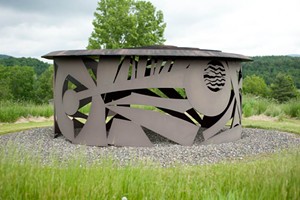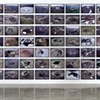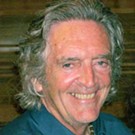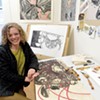Published June 11, 2014 at 10:00 a.m.
David Stromeyer has been building it for more than four decades, but will they come? The combination of a remote location and a lack of signage could challenge anyone searching for Stromeyer's soon-to-open Cold Hollow Sculpture Park. And don't count on finding cell service in the vicinity of this northern Vermont outpost. But persistence will be rewarded once visitors get a glimpse of the 55 large-scale pieces scattered around meadows and atop hillocks on the mountain-ringed, 200-acre property in Enosburg Falls.
The site ranks as one of very few sculpture parks in Vermont — and certainly the largest devoted to the work of a single artist. Free to the public, the display will be inaugurated on Saturday, June 28, with a 1 p.m. tour conducted by Stromeyer, whose work was sampled in a show in 2012 at BCA Center and in Burlington's City Hall Park.
"My blood and soul are here," the 67-year-old sculptor declared last week before leading a Seven Days posse around the land he purchased in 1970. Stromeyer initially made do with only cold running water as he converted a pig and horse barn into the simple home that he and his wife, Sarah, share today. Since choosing the Cold Hollow parcel on the basis of its topographical contours, Stromeyer has painstakingly, and sometimes painfully, created a total of 415 sculptures, nearly all made of steel.
The material doesn't yield easily to an artist's intentions. Stromeyer addresses it with the intense concentration he developed as a ski racer at Dartmouth College and later as a sports-car driver. Careless or distracted practitioners of such daredevilry can be badly injured or killed, and the same dangers stalk sculptors who use heavy machinery to cut, twist and bend beams and sheets of steel into elegant, occasionally playful shapes.
"On any given day, I could get killed doing this," the soft-spoken Stromeyer says matter-of-factly. "I try hard to understand the risk and to moderate or control it."
He's succeeded in that effort so far. But the cumulative effect of grappling with thousands of tons of steel over the past 44 years has taken a physical toll on the slender six-footer. Stromeyer had to have both his hands surgically reconstructed in 2007. "The thumbs were displaced, and I had extreme arthritis," he recounts. "My hands have lived, like, three normal lifetimes."
A perfectionist as well as an inveterate inventor, Stromeyer builds many of the tools he uses. And we're not just talking hammers, saws or welding torches. He's modified hoists and cranes, too.
"I decide what I want to make and then look to see if anything's available for making it," he says. "If not, I build what I need."
Early in his career, Stromeyer seldom applied finishes to his monumental abstractions, which have the rawness and angularity of works by Mark di Suvero that can be seen in sculpture parks and public places around the country. Stromeyer acknowledges di Suvero's influence, along with that of David Smith (1906-1965), a pioneer of abstract-expressionist sculpture.
But, he adds, "I've spent less time in the past 20 years looking at others' work. I'm also less influenced by it. I'm clear on what I want to do."
Years ago, Stromeyer started painting many of his pieces, which generally swoop and swerve rather than standing rigidly upright. His genius is to make something as rigid as steel seem as malleable as clay.
Most of his work remains nonrepresentational, although the artist insists that a few pieces can be considered figurative. That's certainly true of "Things May Have Shifted," in which a two-legged, bending beige form appears to peer with curiosity or concern at an orange shape that seems to be seated below it. A third, purplish element lies curled on its side at the edge of the composition. "Maybe that one's sleeping — or dead," Stromeyer suggests, arching his bushy eyebrows.
The titles he gives his sculptures — always, he emphasizes, after completing them — sometimes hint at images or experiences that may have inspired him. "Windward Passage," for example, is partly shaped like sails, a likely allusion to the many days Stromeyer spent on the water while growing up in Marblehead, Mass. Similarly, "Tango" and "Swingin' Easy" are among a few of the pieces that can readily be seen as dance-inspired, once their titles are read.
The reference points of some other works remain obscure, even as the sculptor intently explains what they're meant to resemble. He describes "Ngozi" and "Jumoke" as paired female and male figures positioned about 20 yards apart. "Ngozi" — an unusual piece for Stromeyer in that it's made of concrete — does taper and curve daintily toward "her" base, but the feminine properties of this 19-foot-tall object may otherwise elude viewers.
That's true, too, of the masculinity that Stromeyer and a booklet available to visitors both identify in "Jumoke." "He" has a thrusting, blue-colored protuberance, but it's where a nose would be, not down where another projection would be found. No matter, though — the two pieces do make a favorable impression, separately or together.
Most of what can be seen at Cold Hollow is purely geometric. One such piece that may bring a smile, along with an admiring gaze, is "Three, Three, Three," a jutting arrangement of three beams, three pipes and three sheets of gray-painted steel that manages to seem weightless and kinetic.
A few pieces are structured as three-sided enclosures, expressive of Stromeyer's fascination with caves. One feels a sense of shelter upon entering "Darwin's Reply," for instance, even though its sloping roof and sides are irregularly perforated, giving fragmented views of trees and fields.
Stromeyer likes to move sculptures around his property from time to time — which is no simple or inexpensive undertaking with such hefty works. In fact, the whole operation at Cold Hollow, including a hangar-size studio resembling a factory, must have cost a fortune to establish, and almost as much to maintain.
Sales made on-site and through Stowe's West Branch Gallery & Sculpture Park, which represents Stromeyer, "defray some of the expenses," he says, of buying and transporting steel from dealers in Montpelier and Plattsburgh, and transforming it into works of art with giant equipment. It helps that the pieces are priced at $10,000 to $120,000. "But if I had to rely on sales to cover the costs..." Stromeyer says, leaving the sentence incomplete. Investing is what keeps him, Sarah and Cold Hollow solvent, he says without elaborating.
There's also the cost of the second home the couple keeps in Austin, Texas. Stromeyer works there on a smaller scale throughout the winter, building models that he will magnify enormously when he returns to his metal works in northern Vermont. "I can make as much noise as I want here without worrying about bothering neighbors," he notes.
That's because only a few people live anywhere near Cold Hollow Sculpture Park. So don't assume you'll be able to ask for directions if you miss the discreet "CHSP" sign at the bottom of the drive off Boston Post Road.
The original print version of this article was headlined "Metal in the Meadows"
More By This Author
Speaking of...
-

Sculptor Clark Derbes Gives New Life to Fallen Wood
Jan 10, 2024 -

Christina Watka’s Installations at Soapbox Arts Dazzle the Eye and Mind
Nov 1, 2023 -

Montréal Museum of Fine Art Revisits the Work of Midcentury Art Star Marisol
Oct 18, 2023 -

Readsboro Artist Sienna Martz Gains a Following for Her Ethical Wall Sculptures
Oct 3, 2023 -

'Amazing Makers' Descend Upon Cold Hollow Sculpture Park This Summer
Jul 5, 2023 - More »
Comments (2)
Showing 1-2 of 2
Comments are closed.
From 2014-2020, Seven Days allowed readers to comment on all stories posted on our website. While we've appreciated the suggestions and insights, right now Seven Days is prioritizing our core mission — producing high-quality, responsible local journalism — over moderating online debates between readers.
To criticize, correct or praise our reporting, please send us a letter to the editor or send us a tip. We’ll check it out and report the results.
Online comments may return when we have better tech tools for managing them. Thanks for reading.
















































